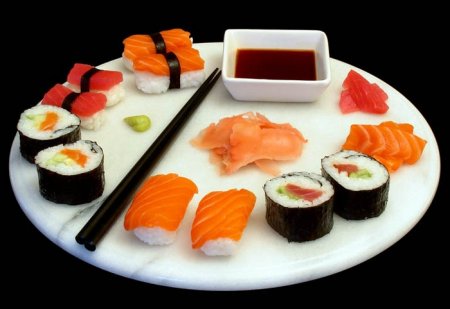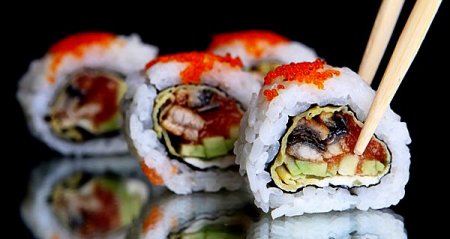Secrets of Japanese Health and Longevity
Here are eight secrets of healthy longevity of the Japanese:
Secret № 1. Basis of Japanese cuisine - it's fish, vegetables, fruits, soy and rice. Fish from the Japanese as we meat.
It is eaten in the morning, afternoon and evening. My favorite Japanese fish - it is salmon, as well as they eat tuna, trout, cod, mackerel, mussels, scallops, shrimp, octopus, squid. The so-called Japanese passion for fish born in VII century AD, when the Emperor passed a law that forbade eating the meat of land animals. Since then, enough time has passed, but fortunately for the Japanese, the ancient traditions are preserved and further strengthened.
Each year, the Japanese eat almost 68 kg of fish per person. This is more than four times higher than in fish consumption in other countries. The Japanese simply "bathed" in the vast ocean of polyunsaturated fatty acids omega-3, which are a significant number of mackerel, sardines, salmon and trout.
Due to the fact that the Japanese eat a lot of fish, the amount of consumption of red meat sharply sokraschaetsya.Yapontsy annually consume about 45 kg of meat per person. In the US, the figure is 130 kg per year in France - 102 kg, in Germany and Velikobritanii- 80 kg. In Japanese dishes much less fat, sugar and calories.
The percentage of fat Japanese food is only 26, while American - 34. Thanks to a diet based on fish, the Japanese are getting more "good fats" - such as omega-3 and less "bad fats" with red meat. In addition, processed and refined foods in Japan per capita consumed far less than in the West, and the total number of calories in food is far lower than in any other country.
Also, the Japanese love fresh vegetables, they are just crazy. The Japanese are very fond of daikon radish, eggplant, spinach, bamboo shoots, lettuce, turnip greens and eat them only in season. They consume five times more cruciferous vegetables - cabbage, broccoli, cauliflower, Brussels sprouts and kale and watercress.
Fruit is eaten in Japan as well as in the West. The main thing that the Japanese consume only fresh fruits that have not been processed. Fruits are not only eaten as a dessert, and they are added to salads. In Japan, the popular apples, apricots, peaches, persimmons, grapes, melons, and citrus flavored Yuji and tangerines. How fruits and vegetables help to save the Japanese health and longevity?
It is a source of vitamins and minerals, they contain almost no calories and fat, but high in fiber and antioxidants. The constant use of fruits and vegetables can significantly reduce the likelihood of cardiovascular disease. Moreover, thanks fitoestragenam contained in Cruciferae (cabbage) reduced the risk of cancer - tumors of the breast and prostate, and of cancer of the oral cavity, larynx, lung, stomach and rectum. Active consumption of fruits and vegetables also helps reduce excess weight.
Even the Japanese are very fond of seaweed - are plants that live in the seas and oceans, with valuable nutritional properties. In Japan it is not conceivable to live a single day without soybeans and soy products - miso soup, tofu and soy sauce. It is a rich source of protein, soy contains all the essential amino acids the body and low-calorie. By its composition, soy protein equivalent to animal protein, but differs a high content of unsaturated fats. Experts believe that a high intake of soy foods in Japan (up to 50 grams per day) serves as an additional factor in health and longevity of the Japanese nation.
Very popular in Japan enjoyed udon noodles or buckwheat soba, but eat it in smaller quantities than the Europeans pasta. In Japan, sold and Western foods, such as pizza or a cheeseburger, but they rarely eat at home. Butter, milk, pasta and red meat the Japanese eat rarely and in small amounts.
Secret № 2. The Japanese food is served in small portions in miniature beautiful dish.
Portions of food in Japan almost a third less than in the west. We eat until satisfied, and the Japanese adhere to the following rule: "Eat until naeshsya 80%." In Japan, food chew very carefully, slowly, savoring every bite, so saturation occurs faster and they almost never experience hunger. Contribute to the slow absorption of food and Japanese chopsticks, they have not much to grab and you will fill your mouth.
Secret № 3. Japanese dishes are Super.
To prepare the food the Japanese resorted to this type of heat treatment that the products retain as many nutrients. In addition, the Japanese used moderately different fatty sauces and very carefully use a variety of seasonings.
There is one important difference: Japanese cook on rapeseed oil or dashi - broth, cooked fish and seaweed and is not used for these purposes, animal fat, butter and heavy oils.
Secret № 4. Instead of bread for every meal Japanese eat rice.
The Japanese eat a lot of rice. Sometimes they use rice four times a day - breakfast, lunch and dinner and a snack, this is the basis of their national cuisine. And bread eaten in small quantities and only in the mornings. Although in recent years young Japanese who inspired European culture began to eat more bread, but try to cook it yourself, as European gourmets, using for this purpose Breadmaker or domestic ovens. But the Japanese tradition of the older generation do not depart and continue to replace grain rice. Rice - it is not only a rich source of complex carbohydrates, vitamins and minerals, there is almost no salt, no saturated fat and cholesterol, so it is so important for health and longevity.
Secret № 5. Energozaryazhayuschy breakfast.
The Japanese do not eat eggs for breakfast with sausage, sweet porridge, pancakes, muffins and cakes. The usual Japanese breakfast consists of a portion of rice, soup - miso with tofu and onion leaves and a piece of seaweed and salmon, necessarily, cups of green tea. Japanese breakfast - the most important and the largest meal, which energizes a long time.
Secret № 6. Japanese and especially fond of Japanese desserts.
We all love something tasty and sweet - chocolate, candy, ice cream, pastries. However, unlike us, the Japanese eat much less sweets and small portions. For example, a typical Japanese cake is three times lower than ours.
Secret №7. The Japanese lead an active lifestyle and a lot of moving during the day.
Unlike the Europeans, the Japanese are more active and mobile - they are more likely to go on foot, overcoming long distances, ride bicycles, climb stairs and much less travel by car.
Forty years ago, a Japanese researcher Yoshiro Hatano suggested that one of the models walk, called "10,000 steps". Now, this model support centers Disease Control and Prevention and sports medicine centers in America. Studies have confirmed that people who every day are 10,000 steps (about 5 miles), characterized by a lower blood pressure and, as a rule, they live longer and slimmer.
Secret № 8. The Japanese tea ceremony.
The Japanese and the Japanese love green tea they drink it with meals, between meals, as a morning "wake-up" and a relaxing bedtime means. The Japanese restaurant serves green tea for free. In addition to green tea, which is the most popular Japanese drink black tea, and in the summer - cold barley tea, called mugichu. No exaggeration to say that the Japanese drink for many centuries.
For the first time tea was introduced to Japan Zen Buddhist monk named Eisai China at the end of the XII century. Gradually, even the tea began to add in some of the dishes - such recipes exist today, for example, porridge of rice and tea. The Japanese have long been linked green tea with health and longevity. Ace tea equated to "the most miraculous medicines that preserve health." Two cups of green tea contain the same amount of bioflavonoids as fruits or vegetables, and half less caffeine than coffee.
So the 12 basic tips for health and longevity in Japan:
1. The following rules Hara hati bumne: eat until you shall be filled to 80%.
2. Keep track of portion sizes: Apply a meal in a small but beautiful plate.
3. Food Chew slowly, savoring every bite.
4. Get in the habit beautifully arrange meals.
5. Eat more fish, fresh fruits and vegetables and less saturated fat.
6. Prepare food on rapeseed oil or rice bran oil.
7. Teach yourself to breakfast, the Japanese, rather than snacking on sandwiches.
8. Suppose that red meat is a rare exception to the main dish with vegetables.
9. Instead of bread and rolls, eat white portion, or better still, brown rice.
10. Avoid sugary soda, better cold drink Japanese tea without sugar and plain water.
11. How can more and longer you walk.
12. Do not forget an important component of a healthy lifestyle is a love of food, so cooking and eating food you have fun.
One last tip about a healthy lifestyle and longevity: try to reduce salt intake and eat more whole-grain products.

